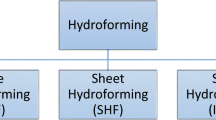Conclusions
The porosity of refractories made from fused materials can be greatly reduced (to 10–13%) by using increased fabrication pressures and coarse grained bodies with low quantities of finely milled bond (10–15%).
The densification mechanism in the coarse-grained bodies consists in breaking up the large grains and redistributing them. The requirement for maximum density of packing in selecting the grain-size composition of the bodies is of first rate importance.
The maximum fabrication pressure should not exceed the values at which the critical density is reached.
Similar content being viewed by others
Literature cited
V.L.Balkevich et al., Trudy D.I. Mendeleev MKhTI, No.59, 163 (1969).
R.Ya.Popil'skii and F.V.Kondrashev, Pressing Ceramic Powders [in Russian], Metallurgiya (1968), p. 125.
A.S.Berezhnoi, Ogneupory, No.3, 124 (1947).
Author information
Authors and Affiliations
Additional information
Translated from Ogneupory No.6, pp.49–53, June, 1972.
Rights and permissions
About this article
Cite this article
Balkevich, V.L., Surkova, I.A., Korshunov, V.S. et al. Using increased fabrication pressures for making articles from certain electrofused highly refractory materials. Refractories 13, 398–401 (1972). https://doi.org/10.1007/BF01284866
Issue Date:
DOI: https://doi.org/10.1007/BF01284866




